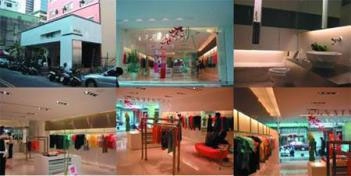Mar , 2004
品牌
撰文/ 黃懷德
在品牌的追求與崇拜,似乎是現代人想要置之不理,都有相當難度的現象,新經濟時代,任何東西都是品牌。綜藝節目、公眾人物、網站、一碗麵、背包、車子、設計師、傢俱一切具象或抽象等等,包括最近的上流美現象。
儘管不是主動追求,往往還是得被動的承受,神奇的原因在於這現象的背後蘊含了可怕的商機,透過創造品牌後的行銷行為發生,促使市場產生必要的回饋,品牌的建立,顯然成為一種不得不為之的流行,且已行之有年。成功與否,端看品牌形成的建立與市場條件相較的差異性。
以室內建築設計產業為例,大概是最熱衷於建立品牌的行業之一,尤其以個人品牌化的建立為最普遍:某某人設計公司、某某設計事務所。就進入職場以來的觀察,普遍來說,老闆就是品牌,經營者就是品牌,追隨者負責用自己的青春及熱情,透過經營者的操作昇華成名牌,對我來說,這種名牌的形成絕對合情合理,因為是背負成敗的經營者先搞出了品牌,而非追隨者。值得討論的是,建立個人品牌並不是要創造虛假的形象,而是關乎經營者對自己的了解,其優勢、技能、價值與熱忱,根據自身的了解來建立,進而符合差異化的基本條件。
我從來都不是很認同品牌的建立太個人化,但是在講究團隊作戰的年代,總還是需要一個有代表性的精神主軸,作為對內或對外的一種宣示。
那追隨者呢?他們付出青春及熱情後的舞台何在?他們的品牌何在?除非雙方在各方面上都有一定程度的平衡,或是所追隨的經營者有高度的視野宏觀,才有機會,才有可能。其難度之高,從光是台北市就有上萬個跑單幫設計師便可觀其一二。我始終相信,一個設計單位裡的每一個參與者,都必須是品牌的一份子,針對品牌的延續性才有優勢,才有條件,因為經營者的設計生命畢竟有限,時間一到,企業的延續便成了考驗,儘管有了傳承,也難保有朝一日沒把創辦人的大名給弄臭。
回過頭來說,據我所知及觀察,設計產業經營者建立品牌大概有以下幾個步驟:
一:設定情境。
建立品牌的情境,其中包括願景與目標。願景是外在的,也就是看到的可能世界;目標則是內在的,也就是為了這個可能的世界所扮演的角色。不是自以為是的,自爽在其中的那種。
二:找出特質。
成功的品牌都是真誠的,經得起檢驗的。品牌需要與本質作結合,所以必須了解自己的團隊。哪些針對性的形容詞時時在環境中出現?哪些特定的說法是別人用來介紹這個團隊的?這些都是強而力的品牌特質。
除了了解自己的團隊,還得了解同業及市場,將品牌傳達給對的人知道。
三:告訴全世界。
隨著設計作品的發表建立品牌宣言。一句傳達個人品牌特質的簡明描述,如同廣告片中的旁白,或是書中前序後跋的標題一樣,無形但有力的深植在人的潛意識,進而作出有效而正面的釋放。不是哪種只有自己聽的懂,或是只有自己的追隨者馬屁賞臉那種。
四:評估、修正、再形成。
如何確知品牌的建立,有助於達成階段性的目標?如何衡量品牌成功與否?關鍵在於必須發展出評量標準。從來自團隊部屬、主管或顧客等等,回饋的反應,找出修正的基礎,調整出更為成熟的品牌特質。
品牌不只是個人標誌而已,而是一種整體評價印象的營造與延續,需要經過一定程度的醞釀,畢竟強勢的大師級品牌,也是經過時間的試煉才逐漸形成的。
名符其實的,不浮誇的品牌是面對市場的第一線,無論是哪一種形式的呈現,都是一種屬於團隊設計生命與精神的延續及加碼。
品牌
撰文/ 黃懷德
在品牌的追求與崇拜,似乎是現代人想要置之不理,都有相當難度的現象,新經濟時代,任何東西都是品牌。綜藝節目、公眾人物、網站、一碗麵、背包、車子、設計師、傢俱一切具象或抽象等等,包括最近的上流美現象。
儘管不是主動追求,往往還是得被動的承受,神奇的原因在於這現象的背後蘊含了可怕的商機,透過創造品牌後的行銷行為發生,促使市場產生必要的回饋,品牌的建立,顯然成為一種不得不為之的流行,且已行之有年。成功與否,端看品牌形成的建立與市場條件相較的差異性。
以室內建築設計產業為例,大概是最熱衷於建立品牌的行業之一,尤其以個人品牌化的建立為最普遍:某某人設計公司、某某設計事務所。就進入職場以來的觀察,普遍來說,老闆就是品牌,經營者就是品牌,追隨者負責用自己的青春及熱情,透過經營者的操作昇華成名牌,對我來說,這種名牌的形成絕對合情合理,因為是背負成敗的經營者先搞出了品牌,而非追隨者。值得討論的是,建立個人品牌並不是要創造虛假的形象,而是關乎經營者對自己的了解,其優勢、技能、價值與熱忱,根據自身的了解來建立,進而符合差異化的基本條件。
我從來都不是很認同品牌的建立太個人化,但是在講究團隊作戰的年代,總還是需要一個有代表性的精神主軸,作為對內或對外的一種宣示。
那追隨者呢?他們付出青春及熱情後的舞台何在?他們的品牌何在?除非雙方在各方面上都有一定程度的平衡,或是所追隨的經營者有高度的視野宏觀,才有機會,才有可能。其難度之高,從光是台北市就有上萬個跑單幫設計師便可觀其一二。我始終相信,一個設計單位裡的每一個參與者,都必須是品牌的一份子,針對品牌的延續性才有優勢,才有條件,因為經營者的設計生命畢竟有限,時間一到,企業的延續便成了考驗,儘管有了傳承,也難保有朝一日沒把創辦人的大名給弄臭。
回過頭來說,據我所知及觀察,設計產業經營者建立品牌大概有以下幾個步驟:
一:設定情境。
建立品牌的情境,其中包括願景與目標。願景是外在的,也就是看到的可能世界;目標則是內在的,也就是為了這個可能的世界所扮演的角色。不是自以為是的,自爽在其中的那種。
二:找出特質。
成功的品牌都是真誠的,經得起檢驗的。品牌需要與本質作結合,所以必須了解自己的團隊。哪些針對性的形容詞時時在環境中出現?哪些特定的說法是別人用來介紹這個團隊的?這些都是強而力的品牌特質。
除了了解自己的團隊,還得了解同業及市場,將品牌傳達給對的人知道。
三:告訴全世界。
隨著設計作品的發表建立品牌宣言。一句傳達個人品牌特質的簡明描述,如同廣告片中的旁白,或是書中前序後跋的標題一樣,無形但有力的深植在人的潛意識,進而作出有效而正面的釋放。不是哪種只有自己聽的懂,或是只有自己的追隨者馬屁賞臉那種。
四:評估、修正、再形成。
如何確知品牌的建立,有助於達成階段性的目標?如何衡量品牌成功與否?關鍵在於必須發展出評量標準。從來自團隊部屬、主管或顧客等等,回饋的反應,找出修正的基礎,調整出更為成熟的品牌特質。
品牌不只是個人標誌而已,而是一種整體評價印象的營造與延續,需要經過一定程度的醞釀,畢竟強勢的大師級品牌,也是經過時間的試煉才逐漸形成的。
名符其實的,不浮誇的品牌是面對市場的第一線,無論是哪一種形式的呈現,都是一種屬於團隊設計生命與精神的延續及加碼。
Brands
by Roy Huang
Following and even worshipping brand names has become a modern phenomenon which is hard to avoid. In the modern economy, everything is involved with brands. Everything concrete or abstract -- including entertainment programs, public figures, websites, a bowl of noodle, knapsacks, cars, designers, furniture, and even the recent phenomenon of ‘shang liou mei’ (her real name being Tsuen-mei Shiu).
Brands do not even need to pursue their fame actively. Often they become known quite passively. There follow many opportunities for business. After brands are created, selling effects happen. Thereafter, brands impel markets to produce the necessary feedbacks. Thus, the establishment of brands becomes an almost compulsory fashion. This situation has existed for many years. Success depends on differences in the establishment of brands and in the conditions of markets.
Take an example of interior design industry which is one of industries which most believes in the establishment of brands. The establishment of brands in the names of individual people is very popular: someone’s design company, someone’s design office etc. According to my observation while working, generally speaking, a boss himself or herself becomes a brand. A manager is a brand. His or her followers use their youth and passion as well as the manager’s operation to improve his brand. To me, forming a brand is quite reasonable because it is the manager who carries his or her responsibility for success or failure and creates his brand first, not his or her followers. What is worthy of discussion is that establishing personal brand is not creation of a false image, but related to something in which the manager understands himself or herself. According to how he or she understands himself or herself, advantages, professional skills, value and passion are established to meet further basic condition.
I never agree with the phenomenon of establishment of a purely personal brand. But, in the modern times, team work is emphasized. So, a representative spiritual axis is needed. The representative becomes an announcement for the inner or outer environment.
How about these followers? What are the stages for these young and enthusiastic followers? What are their brands? Under the balance that manager and followers research, or under the manager having his high and wide view, there are some possible opportunities for these followers. Otherwise, it is so hard for followers – a phenomenon which can be observed from several thousand designers working on a small scale in Taipei. I always believe that every participant in a design organization should become a component of a brand. Extension for the brand is crucial because, after all, the design period for a manager is limited. After limited time has gone by, how to maintain and extend the business becomes a test. There may even be a successor. We never quite know whether this successor may actually damage the original creator’s great brand.
According to my knowledge and observation, a manager’s establishment of a brand in the design industry has following steps.
Firstly, Setting up Environment
The environment of a brand, including outlook for the future and aims, should be set up. The outlook is an outer part and also a world that can be possibly seen. The aim is an inner part and also roles played for the possible world. Setting up an environment is not the kind of thing in which one regards oneself as correct, in total disregard of others’ or public opinions.
Secondly, Finding out Special Characteristics
A successful brand is truthful and is able to be tested. A brand always goes with its own nature. So a manager needs to understand his or her team. What adjectives are often used in the public environment? What special statements are used by others to describe the team? These are strong and powerful characteristics of a brand.
Besides understanding his or her team, a manager needs to understand his or her own industry and market so that a brand can be known by key persons.
Thirdly, Telling the World
The establishment of a brand goes with design displays. A brief and clear sentence which can express characteristics of an individual brand is like a caption for an advertisement or a title for preface or prologue of a book. This powerfully and deeply implants people’s preconsciousness and has an effective and positive influence. This is unlike the situation in which only one person can understand it, or only one’s followers can appreciate it.
Fourthly, Evaluation, Correction and Improvement
How do we know establishment of a brand is helpful to achieve its aim step by step? How do we measure the success of a brand? The key is that it is necessary to develop a standard of evaluation. From the responses of team’s subordinates, bosses or customers, something needs to be found for correction. Then, more mature brand characteristics should be adopted.
A brand is not only an individual symbol, but a construction and extension of the whole impression. It needs to have time from beginning to presentation. All dominant brands are formed through a period of time for testing.
In deed as well as in name, a brand without exaggeration is a front line for facing markets, whatever kind of presentation is made. A brand is a presentation and extension of a design team’s life and spirit.


